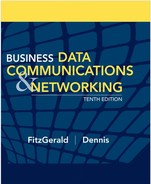CONTENTS
CHAPTER 1 INTRODUCTION TO DATA COMMUNICATIONS
1.1.1 A Brief History of Communications in North America
1.1.2 A Brief History of Information Systems
1.1.3 A Brief History of the Internet
1.2 DATA COMMUNICATIONS NETWORKS
1.3.1 Open Systems Interconnection Reference Model
1.3.3 Message Transmission Using Layers
1.4.1 The Importance of Standards
1.4.2 The Standards-Making Process
1.5.2 The Integration of Voice, Video, and Data
1.5.3 New Information Services
1.6 IMPLICATIONS FOR MANAGEMENT
2.2.1 Host-Based Architectures
2.2.2 Client-Based Architectures
2.2.3 Client-Server Architectures
2.2.4 Peer-to-Peer Architectures
2.4.3 Attachments in Multipurpose Internet Mail Extension
2.6 IMPLICATIONS FOR MANAGEMENT
3.4 DIGITAL TRANSMISSION OF DIGITAL DATA
3.4.4 How Ethernet Transmits Data
3.5 ANALOG TRANSMISSION OF DIGITAL DATA
3.5.3 How Modems Transmit Data
3.6 DIGITAL TRANSMISSION OF ANALOG DATA
3.6.1 Translating from Analog to Digital
3.6.2 How Telephones Transmit Voice Data
3.6.3 How Instant Messenger Transmits Voice Data
3.6.4 Voice over Internet Protocol (VoIP)
3.7 IMPLICATIONS FOR MANAGEMENT
4.3.4 Error Correction via Retransmission
4.3.5 Forward Error Correction
4.3.6 Error Control in Practice
4.4.1 Asynchronous Transmission
4.4.2 Synchronous Transmission
4.6 IMPLICATIONS FOR MANAGEMENT
CHAPTER 5 NETWORK AND TRANSPORT LAYERS
5.2 TRANSPORT AND NETWORK LAYER PROTOCOLS
5.2.1 Transmission Control Protocol (TCP)
5.3.1 Linking to the Application Layer
5.6.1 Known Addresses, Same Subnet
5.6.2 Known Addresses, Different Subnet
5.6.5 TCP/IP and Network Layers
5.7 IMPLICATIONS FOR MANAGEMENT
PART THREE NETWORK TECHNOLOGIES
CHAPTER 6 WIRED AND WIRELESS LOCAL AREA NETWORKS
6.1.2 Dedicated-Server versus Peer-to-Peer LANs
6.2.3 Network Hubs, Switches, and Access Points
6.2.4 Network Operating Systems
6.4.3 Wireless Ethernet Frame Layout
6.4.4 Types of Wireless Ethernet
6.5 THE BEST PRACTICE LAN DESIGN
6.5.3 Designing for SOHO Environments
6.6.1 Improving Server Performance
6.6.2 Improving Circuit Capacity
6.7 IMPLICATIONS FOR MANAGEMENT
7.2 BACKBONE NETWORK COMPONENTS
7.3 BACKBONE NETWORK ARCHITECTURES
7.3.1 Backbone Architecture Layers
7.4 THE BEST PRACTICE BACKBONE DESIGN
7.5 IMPROVING BACKBONE PERFORMANCE
7.5.1 Improving Computer and Device Performance
7.5.2 Improving Circuit Capacity
7.6 IMPLICATIONS FOR MANAGEMENT
8.2.2 Plain Old Telephone Service
8.2.3 Integrated Services Digital Network (ISDN)
8.3 DEDICATED-CIRCUIT NETWORKS
8.3.3 Synchronous Optical Network
8.4.2 Asynchronous Transfer Mode
8.4.5 Multi-Protocol Label Switching
8.6 THE BEST PRACTICE WAN DESIGN
8.7.1 Improving Device Performance
8.7.2 Improving Circuit Capacity
8.8 IMPLICATIONS FOR MANAGEMENT
9.3 INTERNET ACCESS TECHNOLOGIES
9.3.1 Digital Subscriber Line (DSL)
9.4 THE FUTURE OF THE INTERNET
9.5 IMPLICATIONS FOR MANAGEMENT
10.1.1 Why Networks Need Security
10.1.2 Types of Security Threats
10.2.1 Develop a Control Spreadsheet
10.2.2 Identify and Document the Controls
10.2.3 Evaluate the Network's Security
10.3 ENSURING BUSINESS CONTINUITY
10.3.2 Denial of Service Protectio
10.3.4 Device Failure Protection
10.4.2 Perimeter Security and Firewalls
10.4.3 Server and Client Protection
10.4.6 Preventing Social Engineering
10.4.7 Intrusion Prevention Systems
10.5 BEST PRACTICE RECOMMENDATIONS
10.6 IMPLICATIONS FOR MANAGEMENT
11.1.1 The Traditional Network Design Process
11.1.2 The Building-Block Network Design Process
11.2.4 Categorizing Network Needs
11.3.1 Designing Clients and Servers
11.3.2 Designing Circuits and Devices
11.4.2 Selling the Proposal to Management
11.5 DESIGNING FOR NETWORK PERFORMANCE
11.5.4 Minimizing Network Traffic
11.6 IMPLICATIONS FOR MANAGEMENT
12.2 ORGANIZING THE NETWORK MANAGEMENT FUNCTION
12.2.1 The Shift to LANs and the Internet
12.2.2 Integrating LANs, WANs, and the Internet
12.2.3 Integrating Voice and Data Communications
12.3.1 Configuring the Network and Client Computers
12.3.2 Documenting the Configuration
12.4 PERFORMANCE AND FAULT MANAGEMENT
12.4.2 Failure Control Function
12.4.3 Performance and Failure Statistics
12.5.2 Providing End User Training
12.7 IMPLICATIONS FOR MANAGEMENT
APPENDIX B SPANNING TREE PROTOCOL
APPENDIX D CELLULAR TECHNOLOGIES
